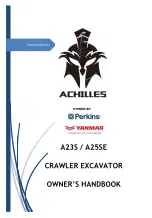
5
4.
SAFE LOADING AND TRANSPORT
OF THE EXCAVATOR
1.
Observe all regulations concerning the
transport of excavators on public roads.
2.
Use adequately long and robust ramps
when loading on a truck. (For details see
“TRANSPORTING THE EXCAVATOR ON
ATRUCK”)
3.
Do not change the running direction and
to avoid a tipping over, do not try to swing
the attachment crosswise to the loading
ramps.
4.
After loading of the excavator on a truck,
engage the swing lock pin.
Lower the attachment on the loading
plane and release the pressure from the
hydraulic system.
Block the tracks with blocks and wire
down the excavator. After loading the
excavator on a truck, tie down the
undercarriage of the excavator with a
strong steel wire on the truck.
5.
Do not brake abruptly with the excavator
loaded. Mortal accidents could happen.
6.
If the excavator is used to tow another
machine, the load must be smaller than
the strength of the hook.
7.
Do not use hooks on the roof of canopy
for lifting the excavator.
Max. drawbar pull at
coupling hook
32.3 kN (3290 kg)
Max. vertical load at
coupling hook
2.7 kN (270 kg)
5. MAINTENANCE
Before doing maintenance work on the
excavator, place the machine on a firm, flat
and level surface, Iower the attachments on
the ground, stop the engine then remove the
key and release the cylinder pressure by
actuating the levers. When dismantling
hydraulic parts, make sure that the hydraulic
oil has cooled down sufficiently to avoid
burns.
Start maintenance work carefully, e.g., loosen
screws slowly so that oil will not squirt out.
1.
Before doing work on the engine, the
exhaust system, the radiator and the
hydraulics, let the excavator cool down
sufficiently.
2.
Turn off the engine at all times when
filling with fuel. Avoid spilling and over-
filling of fuel.
3.
Smoking is prohibited while tanking and
handling the battery! Keep sparks and
fire away from the fuel tank and battery.
Flammable gases escape from the
battery, especially during charging.
4.
Do not use or charge the refillable type
battery if the fluid level is below the
LOWER (lower limit level) mark.
Otherwise, the battery component parts
may prematurely deteriorate, which
may shorten the battery's service life
or cause an explosion. Check the fluid
level regularly and add distilled water as
required so that the fluid level is between
the UPPER and LOWER levels.
5.
Read and follow “STARTING WITH AN
AUXILIARY BATTERY” in “OPERATION
OF THE ENGINE”, when starting with an
auxiliary battery.
Summary of Contents for A23S
Page 1: ...VERSION 09042022 POWER BY A23S A25SE CRAWLER EXCAVATOR OWNER S HANDBOOK...
Page 2: ...NOTE PAGE...
Page 9: ......
Page 16: ...7 6 DANGER WARNING AND CAUTION LABELS 1 Code No RA238 5748 2 2 Code No RA228 5733 1...
Page 17: ...8 1 Code No RC418 5753 2 2 Code No RA228 5762 1 3 Code No RD517 5795 2 Both sides...
Page 21: ......
Page 24: ...15 DESCRIPTION OF MACHINE PARTS...
Page 25: ...16 INSTRUMENTPANELANDCONTROLELEMENTS...
Page 26: ...17...
Page 28: ...19...
Page 43: ...34...
Page 53: ......
Page 64: ...53...
Page 70: ...59...
Page 71: ...60...
Page 72: ...61...
Page 73: ...62...
Page 74: ...63...
Page 75: ...64...
Page 76: ...65...
Page 78: ......
Page 83: ...70...
Page 92: ...79...


































